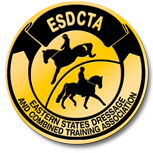A participant and/or spectator are deemed to assume the inherent risks of equine animal activities created by equine animals, weather conditions, conditions of trails, riding rings, training tracks, equestrians, and all other inherent conditions. Each participant is assumed to know the range of his ability and it shall be the duty of each participant to conduct himself within the limits of such ability to maintain control of his equine animal and to refrain from acting in a manner which may cause or contribute to the injury of himself or others, loss or damage to person or property, or death which results from participation in an equine animal activity.
Furthermore: Neither the Organizing Committee, the landowners, nor the Eastern States Dressage and Combined Training Association accept any liability for any accident, injury, or illness to horses, riders, owners, attendants, spectators, or any person or property whatsoever.
All Show Managers and Entry Secretaries are encouraged to obtain a copy of the USEF and/or USEA Rule Books or access the Rule Books online at usef.org or useventing.com, to ensure that shows are run according to current USEF/USEA rules and standards.
